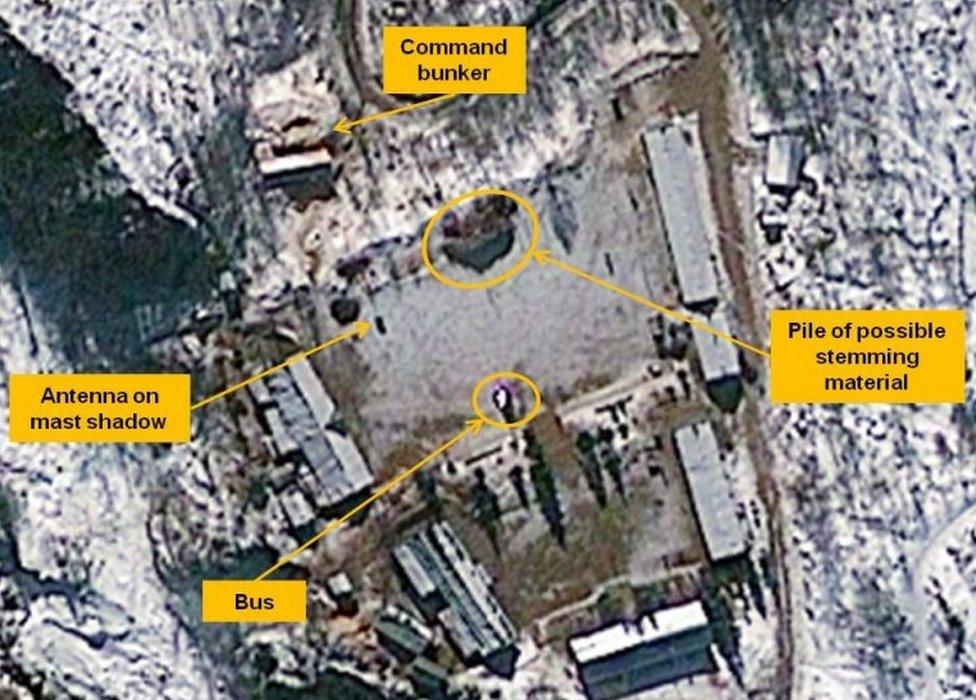North Korea nuclear tests: What did they achieve?
- Published

North Korea has conducted six underground nuclear tests so far and each one has taken it closer to what decades of international talks have tried to prevent - a nuclear weapon in the hands of one of the world's most unpredictable states.
The six tests
9 October 2006 - a weapon for 'peace'
Years of posturing - and attempts at negotiation by foreign powers - culminated in October 2006 with an announcement by Pyongyang, external that it had carried out its first nuclear explosion.
Like all tests that would follow, it took place underground, in tunnels dug into a remote mountainous site called Punggye-ri, in the north-east.

All of the tests have been conducted underground at the Punggye-ri site in the north-east
The device is assumed to have used plutonium, sourced from the North's nuclear facility at Yongbyon.
International observers estimated the blast had an energy discharge of about a kilotonne, less than a tenth of the size of the bomb dropped on Hiroshima in 1945.
Many believed this indicated a nuclear "fizzle" rather than a fully effective blast.
But the North said it had joined the nuclear club, external, and that its bomb would contribute to peace and stability on the Korean peninsula.
25 May 2009 - attempt to prove stability
The second test was bigger, with an estimated yield of between two and eight kilotonnes.
North Korea said it had achieved a "higher level in terms of its explosive power and technology".

The second test, here applauded by Party officials, was seen as an attempt by the North to prove it could still conduct a test despite political uncertainty

The nuclear tests are initially detected by the seismic waves they generate
While the international consensus was that a nuclear test had happened, no radiation was detected. The ability to contain a nuclear test would in itself be a big advance for the North., external
It also followed hard on the heels of a rocket launch which put a satellite in space, but which was seen as a cover for a missile test.
Both were seen as an attempt by ailing leader Kim Jong-il to prove the North's nuclear capacity before he died.
12 February 2013 - uranium-enrichment?
In the early hours of 12 February 2013, unusual seismic activity was again detected around Punggye-ri.
The North said it had tested "a miniaturised and lighter nuclear device with greater explosive force than previously".

Satellite images in days before the blast had indicated a test was about to take place
The reference to "miniaturised" stoked fears that Pyongyang was closer to producing a device small enough to fit on a long-range missile.
Speculation was rife that the test involved a uranium device, though this has never been confirmed beyond doubt. , external
A successful uranium test would mark a significant leap forward in North Korea's nuclear programme. The North's plutonium stocks are finite, but if it could enrich uranium it could build up a nuclear stockpile.
Plutonium enrichment also has to happen in large, easy-to-spot facilities, whereas uranium enrichment can more easily be carried out in secrecy.
6 January 2016 - thermonuclear claim
The first indication was again a report of an "artificial quake" in North Korea, registering about magnitude 5.1, close to Punggye-ri.

North Korea later announced it had conducted its first successful test of a hydrogen bomb.
H-bombs, also known as thermonuclear warheads, are massively more powerful than atomic bombs, using fusion - the merging of atoms - rather than fission to unleash enormous amounts of energy.
Though again it has never been confirmed, that claim alarmed the international community.
Observations from afar suggested the blast detected was not large enough to have been a full thermonuclear device, but may have involved some nuclear fusion.
Again, North Korea said the device had been miniaturised.
A few months later, on 9 March, Kim Jong-un announced that North Korea scientists had been able to do what had long been feared, and make a nuclear warhead small enough to fit on a warhead.
It came after days of threats to carry out "indiscriminate" attacks on the US and South Korea. But analysts at the time said it was impossible to confirm.
9 September 2016 - a major advance
North Korea announced its fifth nuclear test in 2016 in September.
Estimates of the explosive yield have varied. South Korea's military said it was about 10 kilotonnes but other experts say initial indications suggest 20 kilotons or more.
The bomb dropped by the US on Hiroshima in 1945 had a yield of about 15 kilotonnes.

South Koreans react to the latest test
Nearly a year later, on 8 August 2017, information leaked to the Washington Post, external indicated US intelligence officials believe North Korea's claim that it has the technology to fit its missiles with nuclear warheads.
The new assessment comes only weeks after North Korea tested what intercontinental ballistic missiles (ICBM), it says were capable of reaching the US mainland.
3 September 2017 - 'the biggest yet'
North Korea claimed it has successfully tested what the world has worried about - a miniaturised hydrogen bomb that could be loaded on to a long-range missile.

Hours before state media showed North Korean leader Kim Jong-un inspecting what it said was a hydrogen bomb
Seismic readings of 6.3 indicated the test was bigger than any other that has been conducted.
Some early estimates said that the test came in at about 100-150 kilotonnes, potentially 10 times larger than last time.
North Korean state media called it a "perfect success" and a "very meaningful step in completing the national nuclear weapons programme".
- Published21 April 2020

- Published10 August 2017

- Published19 July 2023
